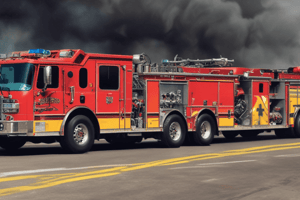Podcast
Questions and Answers
What is the first step in a follow-up report?
What is the first step in a follow-up report?
- Disposition of IRIC
- Accountability started
- Any immediate safety concerns (correct)
- Disposition of resources
What is the correct order of a follow-up report?
What is the correct order of a follow-up report?
- Any immediate safety concerns, Accountability started, Disposition of resources, Disposition of IRIC (correct)
- Disposition of resources, Any immediate safety concerns, Accountability started, Disposition of IRIC
- Accountability started, Disposition of resources, Any immediate safety concerns, Disposition of IRIC
- Accountability started, Any immediate safety concerns, Disposition of resources, Disposition of IRIC
What information is included in the report for an E.M.S. incident?
What information is included in the report for an E.M.S. incident?
- Size of warehouse and type of fire
- Number of patients and severity of injuries (correct)
- Type of vehicle accident and number of patients
- Type of fire and number of exposures
What is the purpose of announcing the initial accountability location?
What is the purpose of announcing the initial accountability location?
Who assumes command of the incident at the scene of a multiple unit response?
Who assumes command of the incident at the scene of a multiple unit response?
When does the initial Incident Commander remain in command?
When does the initial Incident Commander remain in command?
What is the purpose of the initial radio report?
What is the purpose of the initial radio report?
What is included in the standard Initial Radio Report?
What is included in the standard Initial Radio Report?
What is the purpose of declaring a strategy in the initial radio report?
What is the purpose of declaring a strategy in the initial radio report?
When is the first arriving unit or officer not required to assume command?
When is the first arriving unit or officer not required to assume command?
What is the purpose of the command confirmation with the name?
What is the purpose of the command confirmation with the name?
What is an example of an incident that does not require the first arriving unit or officer to assume command?
What is an example of an incident that does not require the first arriving unit or officer to assume command?
Flashcards are hidden until you start studying
Study Notes
Command Procedures
- The first fire department member or unit to arrive at the scene of a multiple unit response shall assume command of the incident.
- The initial Incident Commander shall remain in Command until Command is transferred, or the incident is stabilized and Command is terminated.
Exceptions to Assuming Command
- One or two company responses that are not going to escalate beyond the commitment of these companies do not require the first arriving unit or officer to assume Command.
- Examples of exceptions include single-unit responses, check hazards, and any EMS calls requiring only one or two companies.
Initial Radio Report
- The standard Initial Radio Report includes:
- On-Scene Report
- Unit designation/on the scene
- Building/area description (including occupancy, size, and height)
- Obvious problem/conditions (including smoke and fire showing, working fire, and fully involved)
- Action taken (including assuming command, laying a line, and attacking with...)
- Declaration of Strategy (including offensive or defensive)
- Command confirmation with name
Examples of Initial Radio Reports
- For an offensive structure fire:
- Engine 11 to Alarm: "Engine 11 is on the scene of a large two-story school with a working fire on the second floor. Engine 11 is laying a supply line and going in with a hand-line to the second floor for search & rescue and fire attack. This is an offensive fire attack. Engine 11 will be 7th Street Command."
- For a defensive fire:
- Engine 11 to Alarm: "Engine 11 is on the scene of a medium size warehouse fully involved with exposures to the east. Engine 11 is laying a supply line and attacking the fire with a stang gun and a hand-line to the east exposure to check for extension. This is a defensive fire. Engine 11 will be Buckeye Command."
- For an E.M.S. incident:
- Ladder 11 to Alarm: "Ladder 11 is on the scene with a multi-vehicle accident. Give me the balance of a 2 and 1 medical with three ambulances. Ladder 11 will be Parkway Command."
Follow-up Report
- The Follow-up Report includes:
- Any immediate safety concerns
- Accountability started (announce the initial accountability location)
- Disposition of resources (hold/add/return)
- Disposition of IRIC (only required if IRIC will not be present)
Examples of Follow-up Reports
- For an offensive structure fire:
- 7th Street Command to Alarm: "Engine 11 will be North side accountability. Give me the balance a 1st Alarm."
- For a defensive fire:
- Buckeye Command to Alarm: "Engine 11 will be South side accountability. Give me the balance of a 1st Alarm."
- For an E.M.S. incident:
- Parkway Command to Alarm: "Be advised we have a total of 3 patients, 2 Immediates and 1 delayed. All patients have been extricated."
Studying That Suits You
Use AI to generate personalized quizzes and flashcards to suit your learning preferences.




